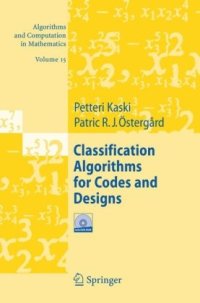
Ebook: Classification Algorithms for Codes and Designs
- Genre: Computers // Algorithms and Data Structures
- Tags: Combinatorics, Computational Mathematics and Numerical Analysis, Coding and Information Theory, Communications Engineering Networks, Signal Image and Speech Processing
- Series: Algorithms and Computation in Mathematics 15
- Year: 2006
- Publisher: Springer-Verlag Berlin Heidelberg
- City: Berlin; New York
- Edition: 1
- Language: English
- pdf
A new starting-point and a new method are requisite, to insure a complete [classi?cation of the Steiner triple systems of order 15]. This method was furnished, and its tedious and di?cult execution und- taken, by Mr. Cole. F. N. Cole, L. D. Cummings, and H. S. White (1917) [129] The history of classifying combinatorial objects is as old as the history of the objects themselves. In the mid-19th century, Kirkman, Steiner, and others became the fathers of modern combinatorics, and their work – on various objects, including (what became later known as) Steiner triple systems – led to several classi?cation results. Almost a century earlier, in 1782, Euler [180] published some results on classifying small Latin squares, but for the ?rst few steps in this direction one should actually go at least as far back as ancient Greece and the proof that there are exactly ?ve Platonic solids. One of the most remarkable achievements in the early, pre-computer era is the classi?cation of the Steiner triple systems of order 15, quoted above. An onerous task that, today, no sensible person would attempt by hand calcu- tion. Because, with the exception of occasional parameters for which com- natorial arguments are e?ective (often to prove nonexistence or uniqueness), classi?cation in general is about algorithms and computation.
This book considers one of the basic problems in discrete mathematics: given a collection of constraints, describe up to isomorphism all the objects that meet them. Only a handful of classification results for combinatorial objects are dated before the mid-20th century; indeed, it is through modern computers and recent developments in algorithms that this topic has flourished and matured. This book is the first comprehensive reference on combinatorial classification algorithms, with emphasis on both the general theory and application to central families of combinatorial objects, in particular, codes and designs.